31.Motion estimation block for HEVC encoder On FPGA,Recent Advances and Innovations
HEVC帧间编码器算法优化
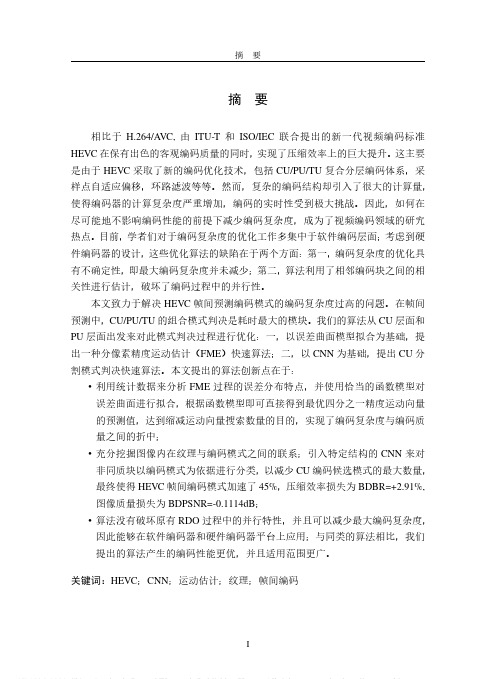
基于提前终止策略改进的运动估计算法

第 22卷第 7期2023年 7月Vol.22 No.7Jul.2023软件导刊Software Guide基于提前终止策略改进的运动估计算法朱鑫磊,汪伟(上海理工大学光电信息与计算机工程学院,上海 200093)摘要:针对HM-16.14中TZSearch标准算法存在的计算复杂度高、耗时相对较长等问题,提出一种基于提前终止策略的改进TZSearch算法。
首先,根据编码产生的率失真代价对编码单元、变换单元和预测单元的深度进行划分,有效避免了额外的划分深度;然后,在TZSearch初始网格搜索过程中,采用钻石搜索和六边形搜索两种搜索方式,根据运动矢量分布位置选择一种更为有效的方式,精确找出最佳匹配点;最后,使用OARP栅格搜索和精细搜索完成运动估计。
由实验结果可知,该方法与标准算法相比,平均降低了60%以上的TZSearch运动估计耗时,且基本不影响视频质量。
关键词:TZSearch算法;提前终止策略;栅格搜索;精细搜索;运动估计DOI:10.11907/rjdk.221887开放科学(资源服务)标识码(OSID):中图分类号:TP391.1 文献标识码:A文章编号:1672-7800(2023)007-0051-08A Modified Motion Estimation Algorithm Based on Early Termination StrategyZHU Xinlei, WANG Wei(School of Optical-Electrical and Computer Engineering, University of Shanghai for Science and Technology,Shanghai 200093, China)Abstract:Considering the high computational complexity and relatively long time consumption of the TZSearch standard algorithm within HM-16.14, an improved TZSearch algorithm based on early termination strategy is proposed to improve the efficiency of video coding. Firstly,the depth sorting of the coding unit, transform unit and prediction unit is calculated according to the performance of rate distortion, which can effectively decrease additional division depths. Secondly, two search methods, i.e. diamond search and hexagonal search, are employed within the initial grid search step of TZSearch in order to precisely find the best matching point according to the motion vector distribution. Finally,OARP raster search and fine search are used to acquire the motion estimation results. Compared with the standard algorithm, experimental re‐sults show that the proposed method reduces more than 60% motion estimation time consumption on average, yet keeps the similar video quali‐ty .Key Words:TZSearch algorithm; early termination strategy; raster search; fine search; motion estimation0 引言随着视频技术的快速发展,依靠视频传递信息变得越来越普及,这使得视频流数据在互联网传输中的占比越来越大。
斑马技术公司DS8108数字扫描仪产品参考指南说明书

基于LBP核密度估计的HEVC运动物体分割算法

基于LBP核密度估计的HEVC运动物体分割算法周巧娣;刘松茹;蒋洁【摘要】针对相对运动缓慢的目标物体在低分辨率视频中分割精度不高的问题,结合高效视频编码(HEVC)压缩码流信息,提出了一种基于局部二值模式(LBP)核密度的运动物体分割方法.首先从视频码流中得到初始运动矢量和块划分信息,初始运动矢量经预处理得到稳定的运动矢量,再利用块信息增强运动矢量区域的可信度,然后采用LBP对运动矢量区域进行特征提取,最后结合核密度估计方法进行背景建模,分割图像并得到运动目标物体.使用多个标准序列进行对比测试实验,结果表明,提出的算法有效提高了相对运动缓慢的目标物体在低分辨率视频图像中的分割精度,综合评价指标的平均值达到81.70%,相比于常用的视频分割方法有较大的提高;对于高分辨率视频图像,其综合评价指标的平均值也较高.【期刊名称】《杭州电子科技大学学报》【年(卷),期】2018(038)003【总页数】6页(P7-12)【关键词】HEVC;运动矢量;LBP;核密度估计【作者】周巧娣;刘松茹;蒋洁【作者单位】杭州电子科技大学电子信息学院 ,浙江杭州310018;杭州电子科技大学电子信息学院 ,浙江杭州310018;杭州电子科技大学电子信息学院 ,浙江杭州310018【正文语种】中文【中图分类】TP391.40 引言在银行、地铁站、学校等监控场景中,往往通过对监控视频序列中相对运动缓慢的物体进行分割来实现目标的识别和跟踪。
但是这些场景中,运动物体识别率的高低很大程度上取决于物体的位置、光照和天气条件以及背景复杂程度等因素。
同时,有限的数据存储空间、不完善的传输技术和设备等因素也导致获得的视频分辨率较低。
目前,视频分割领域的研究多基于图像背景复杂、运动模式多样等情况,而对于运动相对缓慢的物体分割的研究较少。
局部二进制模式(Local Binary Patterns,LBP)算子及其变体在纹理图像检索和分类中扮演重要角色[1],如文献[2]提出了一种从偏振图像中提取LBP特征的方法,将LBP特征与颜色特征结合形成新的特征空间。
HEVC帧内预测模式和分组码的视频信息隐藏_王家骥==
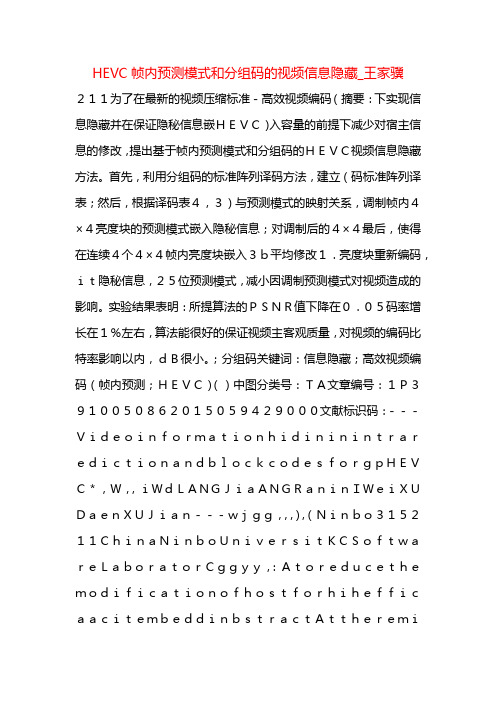
HEVC帧内预测模式和分组码的视频信息隐藏_王家骥211为了在最新的视频压缩标准-高效视频编码(摘要:下实现信息隐藏并在保证隐秘信息嵌HEVC)入容量的前提下减少对宿主信息的修改,提出基于帧内预测模式和分组码的HEVC视频信息隐藏方法。
首先,利用分组码的标准阵列译码方法,建立(码标准阵列译表;然后,根据译码表4,3)与预测模式的映射关系,调制帧内4×4亮度块的预测模式嵌入隐秘信息;对调制后的4×4最后,使得在连续4个4×4帧内亮度块嵌入3b平均修改1.亮度块重新编码,it隐秘信息,25位预测模式,减小因调制预测模式对视频造成的影响。
实验结果表明:所提算法的PSNR值下降在0.05码率增长在1%左右,算法能很好的保证视频主客观质量,对视频的编码比特率影响以内,dB很小。
;分组码关键词:信息隐藏;高效视频编码(帧内预测;HEVC)()中图分类号:TA文章编号:1P3910050862015059429000文献标识码:---VideoinformationhidininintraredictionandblockcodesforgpHEVC*,W,,iWdLANGJiaANGRaninIWeiXUDaenXUJian---wjgg,,,),(Ninbo315211ChinaNinboUniversitKCSoftwareLaboratorCggyy,:AtoreducethemodificationofhostforhihefficaacitembeddinbstractAttheremiseofensurin-gpygpg,)whichisthelatestvideocomressionstandard,aninHEVCinformationhidinvideocodiniencc-pgg(yalorithmforHEVCbasedonintraredictionandblockcodesisroosed.Inthefirstormationhidinfgpppg,,)tablewiththerincileofthestandardarra.Thendecodinlaceweestablisha(43standardarrappygpybetweenthetothemaintheintraredictionmodesin4×4luminanceblocksaccordinwemodifppgpgy,rematrixandtheredictionmode.Finallencodethechanedblockwiththesubstitutiverediction-pygp1.25predictionmode.Itmakesthatfour4×4luminanceblocksembed3bitinformationandmodify,modesonaveraewhichreducestheimactoftheredictionmodemodulationontheualitofthevid-gppqyo.Exerimentalresultsshowthatthebitateincreasesbabout1%andtheeaksinalooiseratioertn---pypg()PSNRlossisustabout0.05dB.Theroosedhidinalorithmcaneffectivelembedinformationjppggywithlittleinfluenceonthebitrateandualitofthecovervideo.-qy;:;();iKewordsinformationhidinhihefficiencvideocodinHEVCntraredictionblockcodepggygy1引言随着数字化多媒体信息应用和传播的普及,1〕。
高效视频编码(HEVC)帧内预测块尺度的快速选择方法
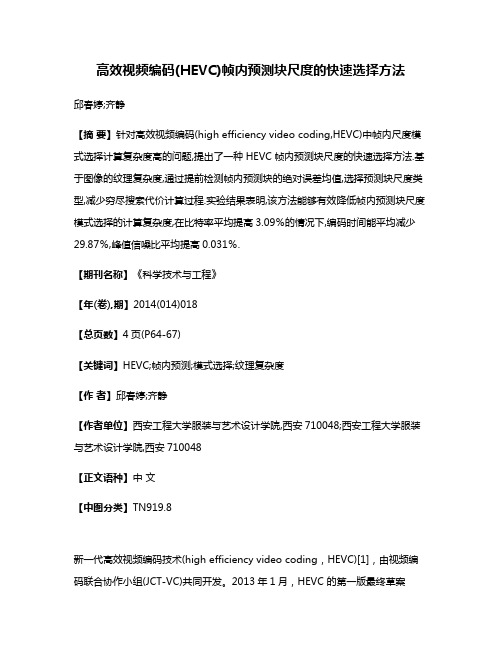
高效视频编码(HEVC)帧内预测块尺度的快速选择方法邱春婷;齐静【摘要】针对高效视频编码(high efficiency video coding,HEVC)中帧内尺度模式选择计算复杂度高的问题,提出了一种HEVC帧内预测块尺度的快速选择方法.基于图像的纹理复杂度,通过提前检测帧内预测块的绝对误差均值,选择预测块尺度类型,减少穷尽搜索代价计算过程.实验结果表明,该方法能够有效降低帧内预测块尺度模式选择的计算复杂度,在比特率平均提高3.09%的情况下,编码时间能平均减少29.87%,峰值信噪比平均提高0.031%.【期刊名称】《科学技术与工程》【年(卷),期】2014(014)018【总页数】4页(P64-67)【关键词】HEVC;帧内预测;模式选择;纹理复杂度【作者】邱春婷;齐静【作者单位】西安工程大学服装与艺术设计学院,西安710048;西安工程大学服装与艺术设计学院,西安710048【正文语种】中文【中图分类】TN919.8新一代高效视频编码技术(high efficiency video coding,HEVC)[1],由视频编码联合协作小组(JCT-VC)共同开发。
2013年1月,HEVC 的第一版最终草案(Main Profile、Main 10 Profile、Main 静止图像 profile)获得 ITU-T 批准,并被命名为 H.265。
HEVC遵循H.264/AVC的核心机制,并采用了多种新的编码技术,显著提高了编码性能[2]。
与H.264/AVC High Profile相比,HEVC可以在保证图像质量不受影响的前提下将码率降低50%,但这是以增加编码计算复杂度为代价的。
如同H.264/AVC,帧内编码是HEVC的重要组成部分,主要利用了帧内预测,残差的空间变换,系数量化和熵编码机制[3]。
在这种机制中,一个有效的帧内预测会产生小的残差并提高编码效率。
因此,帧内预测在HEVC中仍然起着非常重要的作用。
MeGUI PMP向H264视频压制基础教程
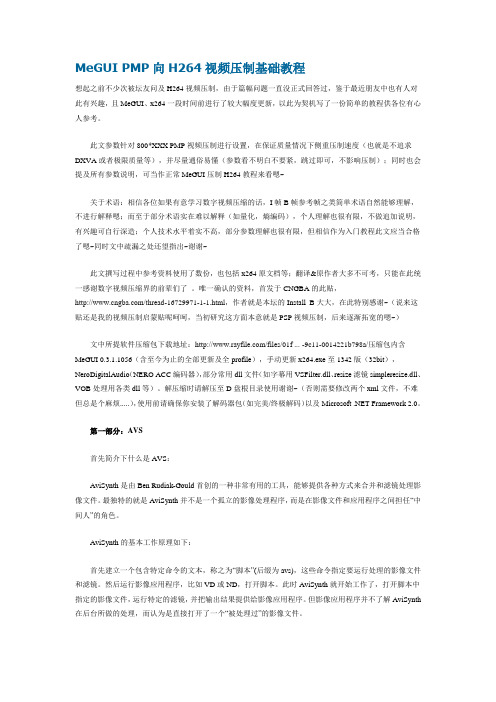
MeGUI PMP向H264视频压制基础教程想起之前不少次被坛友问及H264视频压制,由于篇幅问题一直没正式回答过,鉴于最近朋友中也有人对此有兴趣,且MeGUI、x264一段时间前进行了较大幅度更新,以此为契机写了一份简单的教程供各位有心人参考。
此文参数针对800*XXX PMP视频压制进行设置,在保证质量情况下侧重压制速度(也就是不追求DXVA或者极限质量等),并尽量通俗易懂(参数看不明白不要紧,跳过即可,不影响压制);同时也会提及所有参数说明,可当作正常MeGUI压制H264教程来看嗯~关于术语:相信各位如果有意学习数字视频压缩的话,I帧B帧参考帧之类简单术语自然能够理解,不进行解释嗯;而至于部分术语实在难以解释(如量化,熵编码),个人理解也很有限,不做追加说明,有兴趣可自行深造;个人技术水平着实不高,部分参数理解也很有限,但相信作为入门教程此文应当合格了嗯~同时文中疏漏之处还望指出~谢谢~此文撰写过程中参考资料使用了数份,也包括x264原文档等;翻译&原作者大多不可考,只能在此统一感谢数字视频压缩界的前辈们了。
唯一确认的资料,首发于CNGBA的此贴,/thread-16729971-1-1.html,作者就是本坛的Install_B大大,在此特别感谢~(说来这贴还是我的视频压制启蒙贴呢呵呵,当初研究这方面本意就是PSP视频压制,后来逐渐拓宽的嗯~)文中所提软件压缩包下载地址:/files/01f ... -9c11-0014221b798a/压缩包内含MeGUI 0.3.1.1056(含至今为止的全部更新及全profile),手动更新x264.exe至1342版(32bit),NeroDigitalAudio(NERO ACC编码器),部分常用dll文件(如字幕用VSFilter.dll、resize滤镜simpleresize.dll、VOB处理用各类dll等)。
解压缩时请解压至D盘根目录使用谢谢~(否则需要修改两个xml文件,不难但总是个麻烦.....),使用前请确保你安装了解码器包(如完美/终极解码)以及Microsoft .NET Framework 2.0。
Block-Based Fast Motion Estimation Algorithms in Video Compression
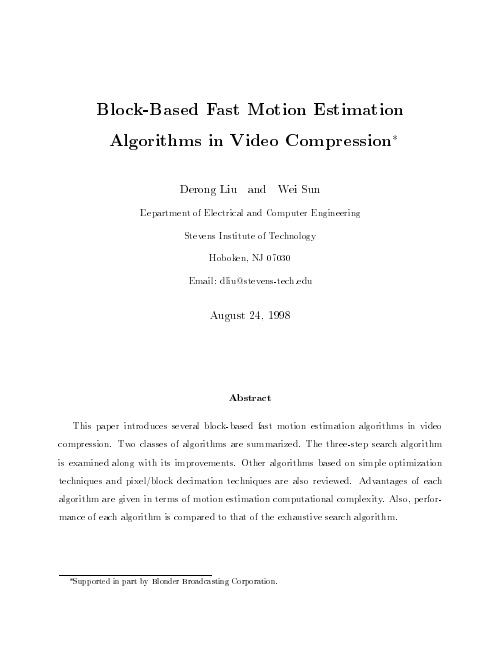
2 The Three-Step Search Algorithm and its Improvements
In 1981, Koga et al. from NEC proposed a fast algorithm for motion estimation which reduces computational requirement in a 3 step search algorithm using block matching 2]. This algorithm has since then become the most popular one for low bit rate video applications such as video phone and video conferencing. In this section, the three-step search (TSS) algorithm 2] will be reviewed and some of its improvements will be summarized 1], 3], 4], 5].
2.1 The Three-Step Search Algorithm
In the three-step search (TSS) algorithm introduced in 2], a maximum displacement p = 6 is usually assumed. The search has three steps and the rst step requires to evaluate the following nine points: one center point and eight other points at 45 steps around the center point. At every step, the point at which the minimum distortion occurs becomes 2
基于帧内预测模式多划分的HEVC鲁棒视频水印算法
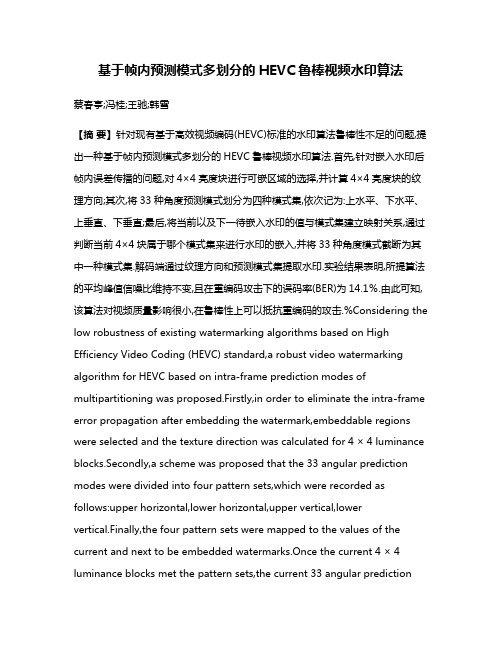
基于帧内预测模式多划分的HEVC鲁棒视频水印算法蔡春亭;冯桂;王驰;韩雪【摘要】针对现有基于高效视频编码(HEVC)标准的水印算法鲁棒性不足的问题,提出一种基于帧内预测模式多划分的HEVC鲁棒视频水印算法.首先,针对嵌入水印后帧内误差传播的问题,对4×4亮度块进行可嵌区域的选择,并计算4×4亮度块的纹理方向;其次,将33种角度预测模式划分为四种模式集,依次记为:上水平、下水平、上垂直、下垂直;最后,将当前以及下一待嵌入水印的值与模式集建立映射关系,通过判断当前4×4块属于哪个模式集来进行水印的嵌入,并将33种角度模式截断为其中一种模式集.解码端通过纹理方向和预测模式集提取水印.实验结果表明,所提算法的平均峰值信噪比维持不变,且在重编码攻击下的误码率(BER)为14.1%.由此可知,该算法对视频质量影响很小,在鲁棒性上可以抵抗重编码的攻击.%Considering the low robustness of existing watermarking algorithms based on High Efficiency Video Coding (HEVC) standard,a robust video watermarking algorithm for HEVC based on intra-frame prediction modes of multipartitioning was proposed.Firstly,in order to eliminate the intra-frame error propagation after embedding the watermark,embeddable regions were selected and the texture direction was calculated for 4 × 4 luminance blocks.Secondly,a scheme was proposed that the 33 angular prediction modes were divided into four pattern sets,which were recorded as follows:upper horizontal,lower horizontal,upper vertical,lowervertical.Finally,the four pattern sets were mapped to the values of the current and next to be embedded watermarks.Once the current 4 × 4 luminance blocks met the pattern sets,the current 33 angular predictionmodes were truncated into the current pattern sets and the watermark was embedded.The watermark was extracted by the texture direction and four prediction pattern sets at decoding side.The experimental results show that,the average Peak Signal to Noise Ratio (PSNR) of the proposed algorithm is almost unchanged.In addition,the proposed algorithm achieves the Bit Error Rate (BER) of 14.1% under re-encodedattacks.Therefore,the proposed algorithm has low video distortion and can well resist the re-encoded attacks in robustness.【期刊名称】《计算机应用》【年(卷),期】2017(037)006【总页数】5页(P1772-1776)【关键词】高效视频编码;帧内预测模式;视频水印;纹理方向【作者】蔡春亭;冯桂;王驰;韩雪【作者单位】华侨大学信息科学与工程学院,福建厦门361021;华侨大学信息科学与工程学院,福建厦门361021;华侨大学信息科学与工程学院,福建厦门361021;华侨大学信息科学与工程学院,福建厦门361021【正文语种】中文【中图分类】TP309.2(*通信作者电子邮箱*************.cn)近年来,非法使用数字化视频的问题日益严重,视频的版权问题变得尤为突出。
HEVC的高效分像素运动补偿
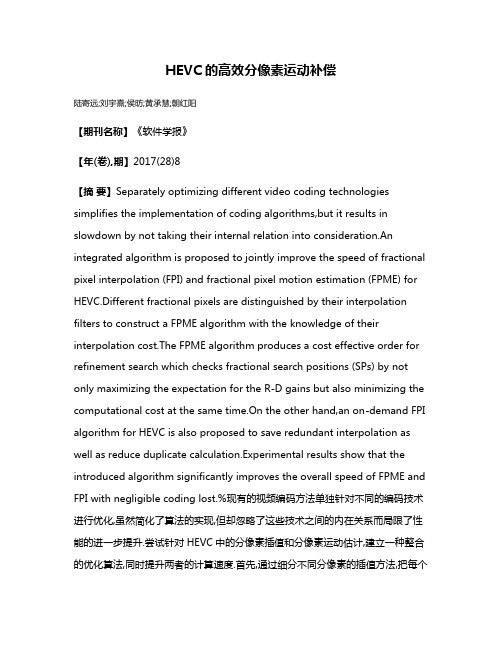
HEVC的高效分像素运动补偿陆寄远;刘宇熹;侯昉;黄承慧;朝红阳【期刊名称】《软件学报》【年(卷),期】2017(28)8【摘要】Separately optimizing different video coding technologies simplifies the implementation of coding algorithms,but it results in slowdown by not taking their internal relation into consideration.An integrated algorithm is proposed to jointly improve the speed of fractional pixel interpolation (FPI) and fractional pixel motion estimation (FPME) for HEVC.Different fractional pixels are distinguished by their interpolation filters to construct a FPME algorithm with the knowledge of their interpolation cost.The FPME algorithm produces a cost effective order for refinement search which checks fractional search positions (SPs) by not only maximizing the expectation for the R-D gains but also minimizing the computational cost at the same time.On the other hand,an on-demand FPI algorithm for HEVC is also proposed to save redundant interpolation as well as reduce duplicate calculation.Experimental results show that the introduced algorithm significantly improves the overall speed of FPME and FPI with negligible coding lost.%现有的视频编码方法单独针对不同的编码技术进行优化,虽然简化了算法的实现,但却忽略了这些技术之间的内在关系而局限了性能的进一步提升.尝试针对HEVC中的分像素插值和分像素运动估计,建立一种整合的优化算法,同时提升两者的计算速度.首先,通过细分不同分像素的插值方法,把每个分像素的插值代价融合在分像素运动估计的搜索中,并构建一种性价比优先的分像素运动估计方法.该运动估计方法的每一步搜索都按照最小化计算代价和最大化率失真收益的原则进行,保证以最小的计算消耗获得最优的性能.其次,为了配合该方法,针对HEVC的特性构建了一种分区域分像素集的分像素插值算法.该插值算法在分像素运动估计过程中仅动态地计算所用到的分像素,解决了现有插值算法无法同时降低重复计算和冗余计算的问题.实验结果表明,该整合算法可以在几乎不产生率失真性能损失的情况下,大幅度地加快分像素运动估计和插值的速度.【总页数】13页(P2214-2226)【作者】陆寄远;刘宇熹;侯昉;黄承慧;朝红阳【作者单位】广东金融学院计算机科学与技术系,广东广州 510521;广东金融学院计算机科学与技术系,广东广州 510521;广东金融学院计算机科学与技术系,广东广州 510521;广东金融学院计算机科学与技术系,广东广州 510521;中山大学软件学院,广东广州510006【正文语种】中文【中图分类】TP391【相关文献】1.基于Cache的HEVC运动补偿带宽优化设计 [J], 郭铮言;方向忠;王慈2.HEVC分像素插值与自适应环路滤波融合结构设计 [J], 李轶夫;蒋毅飞;陈李维;刘宏伟3.HEVC兼容的全景视频运动补偿预测算法 [J], 胡强;马文广;石志儒4.一种分像素运动补偿插值滤波方法及高效VLSI实现 [J], 王荣刚;李锦涛;黄晁;张勇东5.基于二次函数的HEVC快速分像素预测算法 [J], 王钰;于鸿;程磊;严伟;金婕因版权原因,仅展示原文概要,查看原文内容请购买。
基于交替背景模型的HEVC编码研究
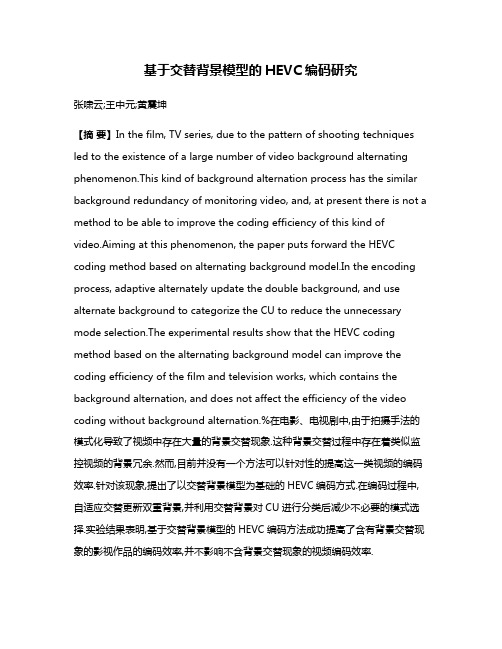
基于交替背景模型的HEVC编码研究张啸云;王中元;黄震坤【摘要】In the film, TV series, due to the pattern of shooting techniques led to the existence of a large number of video background alternating phenomenon.This kind of background alternation process has the similar background redundancy of monitoring video, and, at present there is not a method to be able to improve the coding efficiency of this kind of video.Aiming at this phenomenon, the paper puts forward the HEVC coding method based on alternating background model.In the encoding process, adaptive alternately update the double background, and use alternate background to categorize the CU to reduce the unnecessary mode selection.The experimental results show that the HEVC coding method based on the alternating background model can improve the coding efficiency of the film and television works, which contains the background alternation, and does not affect the efficiency of the video coding without background alternation.%在电影、电视剧中,由于拍摄手法的模式化导致了视频中存在大量的背景交替现象.这种背景交替过程中存在着类似监控视频的背景冗余.然而,目前并没有一个方法可以针对性的提高这一类视频的编码效率.针对该现象,提出了以交替背景模型为基础的HEVC编码方式.在编码过程中,自适应交替更新双重背景,并利用交替背景对CU进行分类后减少不必要的模式选择.实验结果表明,基于交替背景模型的HEVC编码方法成功提高了含有背景交替现象的影视作品的编码效率,并不影响不含背景交替现象的视频编码效率.【期刊名称】《计算机应用与软件》【年(卷),期】2017(034)003【总页数】6页(P131-135,288)【关键词】HEVC;视频编码;背景提取;模式选择;背景交替【作者】张啸云;王中元;黄震坤【作者单位】武汉大学计算机学院国家多媒体软件工程研究中心湖北武汉430072;武汉大学计算机学院国家多媒体软件工程研究中心湖北武汉 430072;武汉大学计算机学院国家多媒体软件工程研究中心湖北武汉 430072【正文语种】中文【中图分类】TP37对话场景在电影、电视剧中占据着非常大的比例。
一种HEVC帧内预测模式快速选择算法
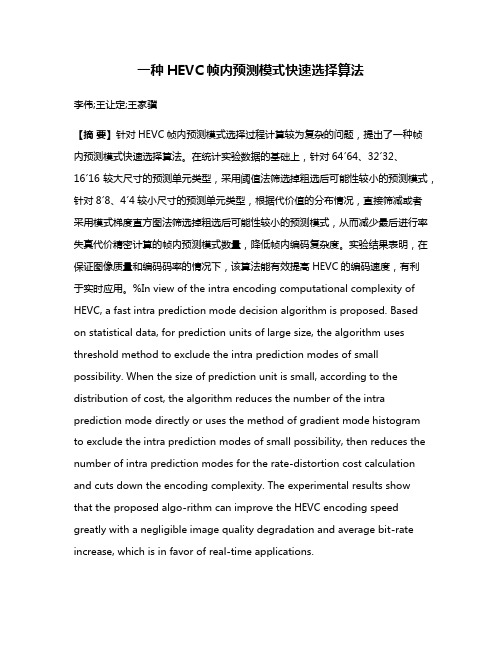
一种HEVC帧内预测模式快速选择算法李伟;王让定;王家骥【摘要】针对HEVC帧内预测模式选择过程计算较为复杂的问题,提出了一种帧内预测模式快速选择算法。
在统计实验数据的基础上,针对64´64、32´32、16´16较大尺寸的预测单元类型,采用阈值法筛选掉粗选后可能性较小的预测模式,针对8´8、4´4较小尺寸的预测单元类型,根据代价值的分布情况,直接筛减或者采用模式梯度直方图法筛选掉粗选后可能性较小的预测模式,从而减少最后进行率失真代价精密计算的帧内预测模式数量,降低帧内编码复杂度。
实验结果表明,在保证图像质量和编码码率的情况下,该算法能有效提高HEVC的编码速度,有利于实时应用。
%In view of the intra encoding computational complexity of HEVC, a fast intra prediction mode decision algorithm is proposed. Based on statistical data, for prediction units of large size, the algorithm uses threshold method to exclude the intra prediction modes of small possibility. When the size of prediction unit is small, according to the distribution of cost, the algorithm reduces the number of the intra prediction mode directly or uses the method of gradient mode histogramto exclude the intra prediction modes of small possibility, then reduces the number of intra prediction modes for the rate-distortion cost calculation and cuts down the encoding complexity. The experimental results show that the proposed algo-rithm can improve the HEVC encoding speed greatly with a negligible image quality degradation and average bit-rate increase, which is in favor of real-time applications.【期刊名称】《计算机工程与应用》【年(卷),期】2016(052)014【总页数】6页(P161-166)【关键词】帧内预测;统计结果;梯度模式直方图;模式选择【作者】李伟;王让定;王家骥【作者单位】宁波大学信息科学与工程学院,浙江宁波 315211;宁波大学信息科学与工程学院,浙江宁波 315211;宁波大学信息科学与工程学院,浙江宁波315211【正文语种】中文【中图分类】TN919.81LI Wei,WANG Rangding,WANG Jiaji.Computer Engineering and Applications,2016,52(14):161-166.高效视频压缩编码标准HEVC(High Efficiency Video Coding)[1],是由ISO/IEC运动图像专家组和ITU-T的视频编码专家组组成的视频编码联合协作组(Joint Collaborative Team on Video Coding,JCT-VC)于2010年4月开始制定,主要针对高清、超高清、3D视频等应用。
基于块划分的HEVC运动目标分割方法

基于块划分的HEVC运动目标分割方法牛志国;梁久祯;吴秦【期刊名称】《计算机工程与应用》【年(卷),期】2016(052)014【摘要】针对压缩域视频的运动对象分割在复杂背景下分割精度不高的问题,提出一种基于最新压缩编码HEVC的运动分割方法。
首先从HEVC压缩码流中提取块划分和相对应的运动矢量信息,并分别在帧内和帧间对运动矢量进行空域和时域的标签分类,然后利用MRF模型对标签场进行运动一致性估计,得到更精确的运动目标,最后输出MRF分割后形成的掩模信息。
通过实验证明,该运动分割方法能够达到有效并可靠的分割效果,尤其对于多目标运动的视频分割效果优于其他比较的方法。
%To solve the problem that the segmentation accuracy of moving object is not high enough under complex back-ground in compressed domain video, this paper proposes a moving object segmentation method based on the up-to-date video coding standard HEVC. Firstly, block partitions and corresponding motion vectors extracted from the HEVC bit-stream are classified based on spatial and temporal consistency in intra frame and inter frames. Then the MRF model is se-lectively exploited to refine the classification result for more accurate video object. Experimental results show that the pro-posed method can achieve an effective and reliable segmentation result, and the method is better than the other compari-son methods especially for multiple target motion video segmentation.【总页数】7页(P202-208)【作者】牛志国;梁久祯;吴秦【作者单位】江南大学物联网工程学院智能系统与计算研究所,江苏无锡214122;江南大学物联网工程学院智能系统与计算研究所,江苏无锡 214122;江南大学物联网工程学院智能系统与计算研究所,江苏无锡 214122【正文语种】中文【中图分类】TP391【相关文献】1.基于改进DRLSE的运动目标分割方法 [J], 胡祝华;赵瑶池;程杰仁;彭金莲2.基于背景学习的运动工件目标分割方法研究 [J], 许小叶;张印辉3.基于图像空间相关性与纹理的HEVC块划分快速算法 [J], 姚英彪;李晓娟4.浅析HEVC参考帧设置与块划分快速算法研究 [J], 李柔梦5.一种基于帧间差与图像分割的运动目标分割方法 [J], 陈娟;应骏;王健;曾爽因版权原因,仅展示原文概要,查看原文内容请购买。
一种高效的HEVC残差四叉树变换快速判决算法
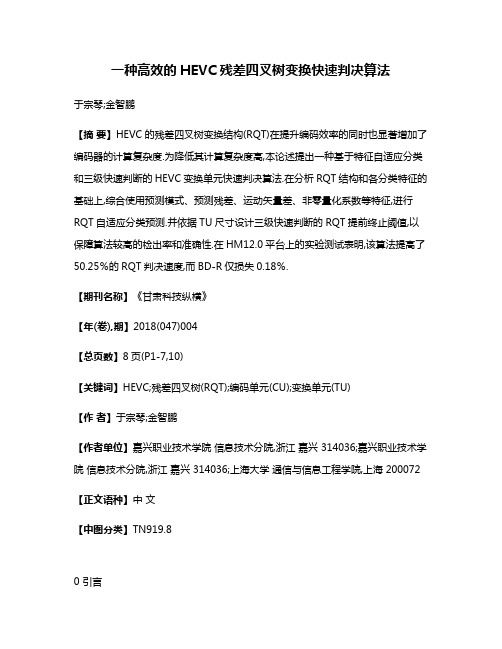
一种高效的HEVC残差四叉树变换快速判决算法于宗琴;金智鹏【摘要】HEVC的残差四叉树变换结构(RQT)在提升编码效率的同时也显著增加了编码器的计算复杂度.为降低其计算复杂度高,本论述提出一种基于特征自适应分类和三级快速判断的HEVC变换单元快速判决算法.在分析RQT结构和各分类特征的基础上,综合使用预测模式、预测残差、运动矢量差、非零量化系数等特征,进行RQT自适应分类预测.并依据TU尺寸设计三级快速判断的RQT提前终止阈值,以保障算法较高的检出率和准确性.在HM12.0平台上的实验测试表明,该算法提高了50.25%的RQT判决速度,而BD-R仅损失0.18%.【期刊名称】《甘肃科技纵横》【年(卷),期】2018(047)004【总页数】8页(P1-7,10)【关键词】HEVC;残差四叉树(RQT);编码单元(CU);变换单元(TU)【作者】于宗琴;金智鹏【作者单位】嘉兴职业技术学院信息技术分院,浙江嘉兴 314036;嘉兴职业技术学院信息技术分院,浙江嘉兴 314036;上海大学通信与信息工程学院,上海 200072【正文语种】中文【中图分类】TN919.80 引言相比 H.264,高效视频编码标准[1](High Efficiency Video Coding,HEVC)将压缩效率提高了一倍,主要面向高清晰度、高帧率、高压缩率的应用需求[2]。
HEVC采用了高度灵活的块划分方式[3],包括递归四叉树结构的编码树(Coding Tree Units,CTU)、编码单元(Coding Units,CU)、预测单元(Prediction Units,PU)和变换单元(Transform Units,TU)。
在HEVC中,每一帧图像被划分成数个CTU,每个CTU又按照递归四叉树结构划分成一个或多个不同深度(depth)的编码单元CU[4]。
得益于树状结构的处理流程,残差四叉树变换(Residual Quad-Tree Transform,RQT)[5]能使TU尺寸自适应于残差的分布特征,可进一步提高编码效率;但同时也引入了额外的计算复杂度,严重影响HEVC编码器的实时编码性能[6]。
利用运动信息及率失真代价的HEVC帧间快速算法
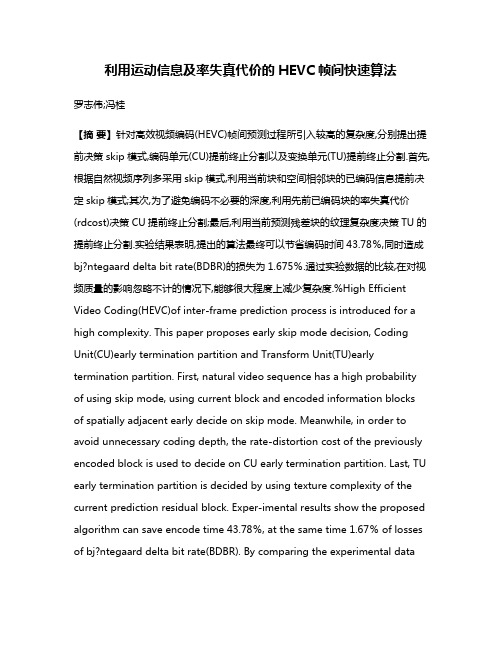
利用运动信息及率失真代价的HEVC帧间快速算法罗志伟;冯桂【摘要】针对高效视频编码(HEVC)帧间预测过程所引入较高的复杂度,分别提出提前决策skip模式,编码单元(CU)提前终止分割以及变换单元(TU)提前终止分割.首先,根据自然视频序列多采用skip模式,利用当前块和空间相邻块的已编码信息提前决定skip模式;其次,为了避免编码不必要的深度,利用先前已编码块的率失真代价(rdcost)决策CU提前终止分割;最后,利用当前预测残差块的纹理复杂度决策TU的提前终止分割.实验结果表明,提出的算法最终可以节省编码时间43.78%,同时造成bj?ntegaard delta bit rate(BDBR)的损失为1.675%.通过实验数据的比较,在对视频质量的影响忽略不计的情况下,能够很大程度上减少复杂度.%High Efficient Video Coding(HEVC)of inter-frame prediction process is introduced for a high complexity. This paper proposes early skip mode decision, Coding Unit(CU)early termination partition and Transform Unit(TU)early termination partition. First, natural video sequence has a high probability of using skip mode, using current block and encoded information blocks of spatially adjacent early decide on skip mode. Meanwhile, in order to avoid unnecessary coding depth, the rate-distortion cost of the previously encoded block is used to decide on CU early termination partition. Last, TU early termination partition is decided by using texture complexity of the current prediction residual block. Exper-imental results show the proposed algorithm can save encode time 43.78%, at the same time 1.67% of losses of bj?ntegaard delta bit rate(BDBR). By comparing the experimental dataunder the condition that the quality of video is negligible, can largely reduce the complexity of encoder.【期刊名称】《计算机工程与应用》【年(卷),期】2017(053)021【总页数】7页(P167-173)【关键词】高效视频编码;已编码信息;率失真代价;残差块【作者】罗志伟;冯桂【作者单位】华侨大学信息科学与工程学院,福建厦门 361021;华侨大学信息科学与工程学院,福建厦门 361021【正文语种】中文【中图分类】TN919.81高效视频编码的提出有利于满足人们对如今高清视频(2K和4K)的需求。
HEVC兼容的全景视频运动补偿预测算法
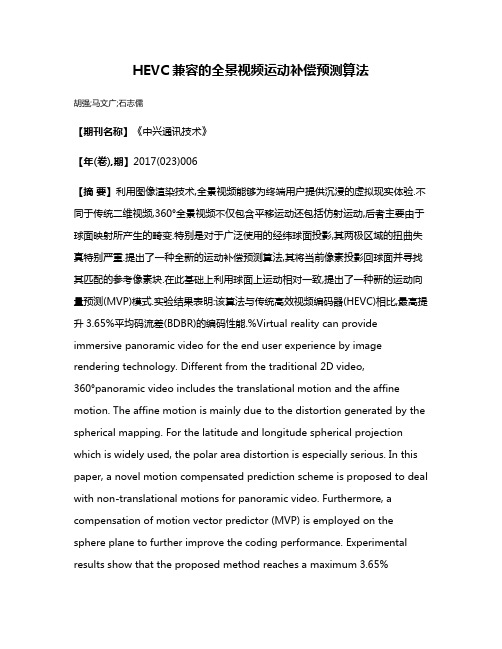
HEVC兼容的全景视频运动补偿预测算法胡强;马文广;石志儒【期刊名称】《中兴通讯技术》【年(卷),期】2017(023)006【摘要】利用图像渲染技术,全景视频能够为终端用户提供沉浸的虚拟现实体验.不同于传统二维视频,360°全景视频不仅包含平移运动还包括仿射运动,后者主要由于球面映射所产生的畸变.特别是对于广泛使用的经纬球面投影,其两极区域的扭曲失真特别严重.提出了一种全新的运动补偿预测算法,其将当前像素投影回球面并寻找其匹配的参考像素块.在此基础上利用球面上运动相对一致,提出了一种新的运动向量预测(MVP)模式.实验结果表明:该算法与传统高效视频编码器(HEVC)相比,最高提升3.65%平均码流差(BDBR)的编码性能.%Virtual reality can provide immersive panoramic video for the end user experience by image rendering technology. Different from the traditional 2D video,360°panoramic video includes the translational motion and the affine motion. The affine motion is mainly due to the distortion generated by the spherical mapping. For the latitude and longitude spherical projection which is widely used, the polar area distortion is especially serious. In this paper, a novel motion compensated prediction scheme is proposed to deal with non-translational motions for panoramic video. Furthermore, a compensation of motion vector predictor (MVP) is employed on the sphere plane to further improve the coding performance. Experimental results show that the proposed method reaches a maximum 3.65%Bjontegaard Delta Bitrate (BDBR) reductions compared to high efficiency video coding (HEVC).【总页数】4页(P28-31)【作者】胡强;马文广;石志儒【作者单位】上海交通大学,上海 200240;上海科技大学,上海201210;上海科技大学,上海201210【正文语种】中文【中图分类】TN929.5【相关文献】1.基于Cache的HEVC运动补偿带宽优化设计 [J], 郭铮言;方向忠;王慈2.基于机器学习的HEVC快速帧内预测算法研究进展 [J], 艾达;卢雪磊;高阳;董久军3.HEVC的高效分像素运动补偿 [J], 陆寄远;刘宇熹;侯昉;黄承慧;朝红阳4.HEVC帧内预测算法加速设计与实现 [J], 王飞龙; 刘新闯; 刘鹏; 辛晓斐; 石鹏飞5.基于二次函数的HEVC快速分像素预测算法 [J], 王钰;于鸿;程磊;严伟;金婕因版权原因,仅展示原文概要,查看原文内容请购买。
基于改进SSIM的HEVC率失真优化
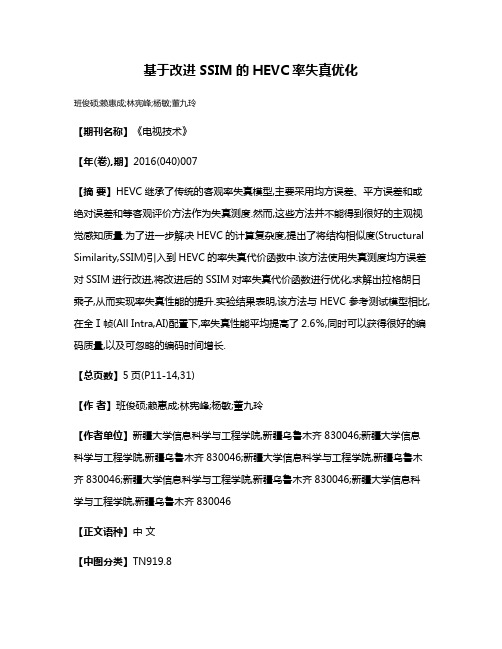
基于改进SSIM的HEVC率失真优化班俊硕;赖惠成;林宪峰;杨敏;董九玲【期刊名称】《电视技术》【年(卷),期】2016(040)007【摘要】HEVC继承了传统的客观率失真模型,主要采用均方误差、平方误差和或绝对误差和等客观评价方法作为失真测度.然而,这些方法并不能得到很好的主观视觉感知质量.为了进一步解决HEVC的计算复杂度,提出了将结构相似度(Structural Similarity,SSIM)引入到HEVC的率失真代价函数中.该方法使用失真测度均方误差对SSIM进行改进,将改进后的SSIM对率失真代价函数进行优化,求解出拉格朗日乘子,从而实现率失真性能的提升.实验结果表明,该方法与HEVC参考测试模型相比,在全Ⅰ帧(All Intra,AI)配置下,率失真性能平均提高了2.6%,同时可以获得很好的编码质量,以及可忽略的编码时间增长.【总页数】5页(P11-14,31)【作者】班俊硕;赖惠成;林宪峰;杨敏;董九玲【作者单位】新疆大学信息科学与工程学院,新疆乌鲁木齐830046;新疆大学信息科学与工程学院,新疆乌鲁木齐830046;新疆大学信息科学与工程学院,新疆乌鲁木齐830046;新疆大学信息科学与工程学院,新疆乌鲁木齐830046;新疆大学信息科学与工程学院,新疆乌鲁木齐830046【正文语种】中文【中图分类】TN919.8【相关文献】1.基于显著特征的HEVC帧内率失真优化 [J], 李金龙;陈芬;彭宗举;蒋刚毅;郁梅2.基于率失真优化的HEVC帧内编码模式选择 [J], 乔莉;李博;刘伟杰3.一种基于SSIM的HEVC率失真优化编码方法 [J], 郑明魁;施隆照;杨秀芝;叶张帆4.基于视觉感知的HEVC率失真优化算法 [J], 李津津;王凤随5.基于视频内容自适应拉格朗日参数选择的HEVC率失真编码优化 [J], 杨琳;何书前;石春因版权原因,仅展示原文概要,查看原文内容请购买。
- 1、下载文档前请自行甄别文档内容的完整性,平台不提供额外的编辑、内容补充、找答案等附加服务。
- 2、"仅部分预览"的文档,不可在线预览部分如存在完整性等问题,可反馈申请退款(可完整预览的文档不适用该条件!)。
- 3、如文档侵犯您的权益,请联系客服反馈,我们会尽快为您处理(人工客服工作时间:9:00-18:30)。
Motion estimation is the most important temporal prediction technique used in video compression. The underlying idea of motion estimation technique can be attributed to the similarity in the consecutive video frames setting apart the changes caused by objects in motion within the frames. It is easy for the encoder to efficiently predict the current frame as a duplicate of the prediction frame in the trivial case of zero motion between frames (and no other differences caused by noise, etc.). Once this is done, the only information needed to transmit to the decoder will be the syntactic overhead necessary for the reconstruction of the picture from the original reference frame.
adaptive offset. Out of these, motion estimation/compensation is the most significant process of video compression as it helps in the removal of the temporal redundancy of the video content to a larger extent. The motion estimation tool finds those motion vectors in the past (or future frames) whose block position matches for every block in the current video frame. These motion vectors are then used in the generation of compensated frames by the motion compensation. It stands out to be the most challenging and time consuming stage in the whole process. Motion estimation of blocks of varying sizes and the presence of multiple reference frames can be counted responsible for this. The cumulative effect of all these factors contributes to the larger encoding time consumed by the ME. This part of the problem could be effectively tackled with the help of efficient algorithms that helps in reducing the overall time consumed.HEVC is designed with the idea of reducing the effective bit-rate down to half of video quality while compared to AVC high profile encoding. The reduction in bit rate could be achieved by employing encoder computation with higher complexity which subsequently requires larger CPU power than the AVC high profile encoding. The rest of the paper is organized as follows. Section II showcases the overview of the motion estimation in HEVC, followed by proposed hardware approach and the corresponding architecture in section III. The implementation results and comparisons are listed in section IV and finally, the conclusion is presented in the section V. II.
Abstract-The world of digital electronics and video compression has become so popular and advanced in such a way that the capture, display and transmission of the ultra-high definition video have become a common thing and is used in various related fields. Due to limited band width and stringent requirements of real-time video play back, video coding is an indispensable process for many visual communication applications and always requires a very high compression ratio. To support this growing popularity and consumer demand, lTU has come up with a new standard HEVC (High Efficiency Video Coding). The new codec helps in achieving the same video quality of the established H.264/A VC codec utilizing just half of the band width, which is notably the greatest advantage it has to offer. Based on the study of motion vector distribution from several commonly used test image sequences, a new diamond search algorithm for fast Motion Estimation (ME) for HECV encoder is proposed in this paper. This algorithm is simple, robust and efficient ensuring low complexity paralleled with high quality in finding global minimum. Keywords- HEVC; Video coding; Motion estimation (ME); Sum of absolute differences (SAD); H.264; Diamond searcll;Coding units(CU).
Mrs.Vidya\ekshmi.V.G Dept. of Electronics and Communication PES Institute of Technology, Bangalore, India vidya0055@yahoo.co.in Prof. Deepa Yagain Dept. of Electronics and Communication PES Institute of Technology, Bangalore, India deepa.yagain@ Mr.Ganesh Rao K Tata Elxsi Ltd. ITPB Main Road, Bangalore, India.
MOTION ESTIMATION IN HEVC
I.
INTRODUCTION
Motion estimation eliminates temporal redundancy information between successive frames there by enhancing the encoding efficiency. This has been adopted by various video coding standards. HEVC is a state-of-the art standard in video compression rendering more accurate prediction and higher compression efficiency. In the years to come, this new standard HEVC [1] would be impacting on a large scale the areas of mobile communication, television broadcasting, multimedia streaming and video capture & storage areas. HEVC standard is merited with features like lower memory bandwidth, less average interpolation complexity (due to the 1D directional interpolation filters) and twice the compression efficiency in comparison with its predecessors H.264/MPEG-4 AVC[2]. HEVC has been proposed with a vision to minimize the complexity and computation load involved in the motion estimation. The various features of HEVC are coding units and coding blocks, prediction units and prediction blocks, transform units and transform blocks, motion vector signaling, motion compensation, intra-picture prediction, quantization control, entropy coding, in-loop deblocking filtering and sample
